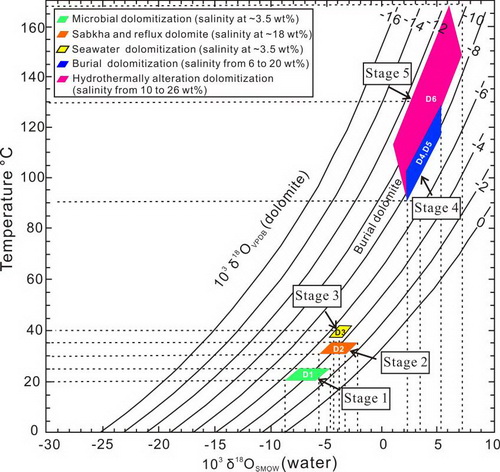
Deeply buried dolostone reservoirs of Cambrian and Precambrian ages are hot targets for present-day exploration in both the Tarim Basin and Sichuan Basin in China because of their great potential for future discoveries of petroleum resources.
Understanding the origin, occurrence, and distribution of dolomites is of great importance in exploration and production planning in these reservoirs.
Associate Prof. JIANG Lei and his colleagues from Institute of Geology and Geophysics of the Chinese Academy of Sciences, found that five stages of dolomitization were responsible for the formation of various types of dolomite in the deeply buried Cambrian unit in the Tarim Basin, northwest China.
They further related the different dolomitization events to the origin of various types of pore space in these reservoirs. This work was published in Sedimentology.
Dolomite samples were collected from well cores across the whole basin, and from several outcrops at the northwestern edge of the basin.
A combination of petrology, fluid-inclusion microthermometry, and stable and radiogenic-isotopes was used to identify different types of dolomite and characterize the dolomitization fluids. Dolomitization occurred in a wide diagenetic range from syndepositional (at ~ 25 °C) to deeply burial environments (as high as 170 °C) in these reservoirs.
Five stages of dolomitization are (listed in formation time order): microbial dolomitization (restricted to lagoon facies), reflux dolomitization (mostly in lagoon and sabkha facies, some in shoal and reef facies), seawater dolomitization (shoal and reef facies), burial dolomitization (shoal and reef facies, carbonate platform), hydrothermal dolomitization (fracture related). Intercrystalline, moldic, and breccia porosities are due to the early stages of dolomitization. Macroscopic, intergranular, vuggy, fracture and dissolution porosity are due to burial-related dissolution and regional hydrothermal events.
This work has shown that old (i.e., Cambrian or even Precambrian) sucrosic dolostone associated with anhydrite, buried to as deep as 8,000 m, can still have a high potential for hosting substantial hydrocarbon resources and should be globally targeted for future exploration.
The study entitled "Multiphase dolomitization of deeply buried Cambrian petroleum reservoirs, Tarim Basin, north-west China" was done in collaboration with University of Liverpool, University of Texas at Austin, and Tarim Oilfield Company, Petrochina.
The work was supported by the National Natural Science Foundation of China, Special Major Project on Petroleum Study, and the Office of China Postdoctoral Council.

Figure 1. Outcrop photo showing abundant vuggy porosity in the Camrbian dolostone of the Tarim Basin. (Image by JIANG Lei)

Figure 2. Five stages of dolomitization occurred in the Cambiran dolostone reservoirs. Each stage have distict temperature, salinity, and oxygen isotope of the dolomization water. (Image by JIANG Lei et al.)

86-10-68597521 (day)
86-10-68597289 (night)

86-10-68511095 (day)
86-10-68512458 (night)

cas_en@cas.cn

52 Sanlihe Rd., Xicheng District,
Beijing, China (100864)

